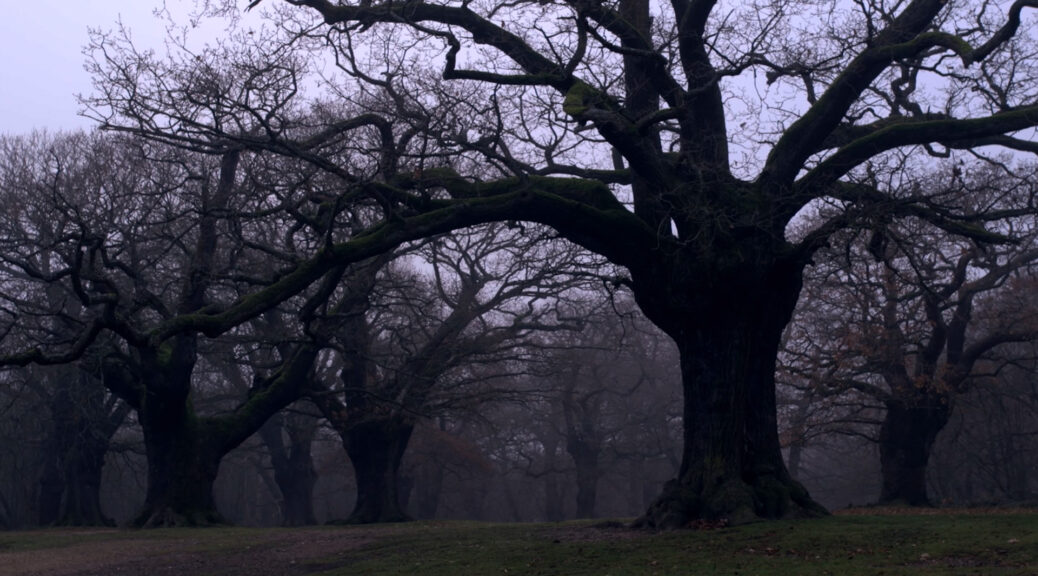Ghosts! Maybe the first ever scary idea in all of history, the first thing to haunt our dreams. To give us the word haunt. Ghosts have been a staple of horror for as long as there was such a thing, so it was with great difficulty that we narrowed down our five favorite ghosts in horror movies.
We welcome director George Popov back to the podcast to run down the whole list. Keep up to date on his Sideworld documentary series and grab the cool merch we talk about by visiting sideworld.co.uk and following them on Twitter @Sideworld._UK, Facebook @SideworldUK and Instagram @sideworld_uk.
5. Santi in Devil’s Backbone (2001)
The Devil’s Backbone unravels a spectral mystery during Spain’s civil war. The son of a fallen comrade finds himself in an isolated orphanage that has its own troubles to deal with, now that the war is coming to a close and the facility’s staff sympathized with the wrong side. That leaves few resources to help him with a bully, a sadistic handyman, or the ghost of a little boy he keeps seeing.
Backbone is a slow burn as interested in atmosphere and character development as it is in the tragedy of a generation of war orphans. This is ripe ground for a haunted tale, and writer/director Guillermo del Toro’s achievement is both contextually beautiful – war, ghost stories, religion and communism being equally incomprehensible to a pack of lonely boys – and elegantly filmed.
Plus the ghost looks awesome. Del Toro would go on to create some of cinema’s more memorable creatures, and much of that genius was predicted in the singular image of a drowned boy, bloody water droplets floating about him, his insides as vivid as his out.
Touching, political, brutal, savvy, and deeply spooky, Backbone separates del Toro from the pack of horror filmmakers and predicts his own potential as a director of substance.
4. Jennett Humfrye in The Woman in Black (2012)
Director James Watkins was fresh off his underseen, wickedly frightening Eden Lake. Screenwriter Jane Goldman (working from Susan Hill’s novel) had recently written the films Kick-Ass and X-Men: First Class, both of which are awesome. And star Daniel Radcliffe had done something or other that people remembered…
I’d have been worried that Radcliffe chose another supernatural adventure as his first big, post-Hogwarts adventure were it not for the filmmaking team putting the flick together. Goldman’s witty intelligence and Watkins’s sense of what scares us coalesce beautifully in this eerie little nightmare.
A remake of a beloved if rarely shown BBC film, the big screen version is a spooky blast of a ghost story. It makes savvy use of old haunted house tropes, updating them quite successfully, and its patient pace and slow reveal leads to more of a wallop than you usually find in such a gothic tale. Glimpses, movements, shadows—all are filmed to keep your eyes darting around the screen, your neck craned for a better look. It’s classic haunted house direction and misdirection laced with more modern scares.
3. Toshio in Ju-On: The Grudge (2002)
Yuya Ozeki was 5 years old when his melancholy, cherubic little face first appeared in Takashi Shimizu’s Ju-On: The Grudge. He’d reprise his role as Toshio in Shimizu’s Japanese sequel as well as his English language remake of the original.
Ozeki’s presence onscreen is the perfect combination of adorable and terrifying. He sticks around this one hours, makes a mess, runs his little feet all over the place, sometimes meows.
The real gut punch of The Grudge series is that the ghosts are inescapable. You are doomed from the moment you set foot in Toshio and Kakayo’s home. It’s a way that the film perverts expectations of the gothic tale, and that corruption of something elegant is no more perfectly encapsulated than in the guide of little Toshio.
2. The Staff in The Others (2001)
Writer/director Alejandro Amenábar casts a spell that recalls The Innocents in his 2001 ghost story The Others. It’s 1945 on a small isle off Britain, and the brittle mistress of the house (Nicole Kidman) wakes screaming. She has reason to be weary. Her husband has still not returned from the war, her servants have up and vanished, and her two children, Anna and Nicholas, have a deathly photosensitivity: sunlight or bright light could kill them.
The new staff – Mrs. Mills (Fionnula Flanagan), Mr. Tuttle (Eric Sykes) and Lydia (Elaine Cassidy) – is here to help. Amenábar uses these three beautiful performances as a way to talk to Kidman’s harried mum as well as the audience. Flanagan, in particular, is brilliant.
What unspools is a beautifully constructed film using slow reveal techniques to upend traditional ghost story tropes, unveiling the mystery in a unique and moving way.
1. Delbert Grady in The Shining (1980)
Have we talked about this movie before? As is true with The Others, The Shining offers a smorgasbord of ghosts to choose from: Lloyd the bartender, the little Grady sisters, the old lady in the bathtub, the guy in the bear suit. But we settled on Grady because he may come across like the help, but don’t let that fool you. Grady’s the one in charge.
In one of the greatest single scenes in a horror film – and one that contains no murder at all – Delbert quietly clarifies the power structure at work for Mr. Torrence.
Stanley Kubrick’s camera is, per usual, meticulous in creating an atmosphere that mirrors this shift in power. Jack Nicholson’s transformation from smug to obedient is glorious. But it’s longtime character actor Philip Stone who nails the terrifying nuance that amounts to the most pivotal moment in Kubrick’s masterpiece.







